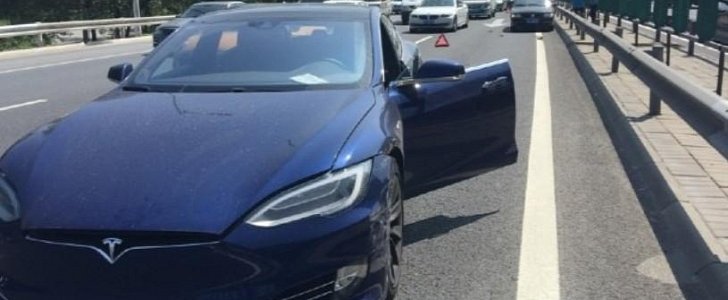Semi-autonomous driving functions are not an excuse for laziness or incompetence. That should be written in full caps and bold letters on the disclaimer of cars that have them.
Last week, we reported an accident in China that took place while the driver was using the Autopilot feature on his Tesla Model S. The accident was a fender-bender, and both cars drove away after it occurred. The Model S sideswiped a vehicle that was stranded on the leftmost lane of a highway.
However, Tesla’s Autopilot system still got the “mandatory flak” from Internet users, and the driver of the vehicle blames both the American company, and its local sales staff.
Luo Zhen, the 33-year-old programmer that was in the driver’s seat of the Tesla Model S, has claimed that the sales team promoted the system as “self-driving,” and that this is why he expected the automobile to be capable of avoiding the impact alone.
While we do agree that it is peculiar that the system could not “see” and avoid a car that was parked in its lane, we still think that the driver is at fault for not having his hands on the wheel. The latter was suggested in a statement from the American automaker that has declared that data recorded showed that the driver did not have at least a hand on the steering wheel, which is against the law in China. And in the rest of the world, by the way.
Tesla officials have underlined this fact in every statement regarding the Autopilot system — it does not make the car a self-driving vehicle, and the driver is asked to keep at least one hand on the wheel at all times and be attentive to traffic.
As Automotive News notes, the Tesla website in China has the term “zidong jiashi” featured in multiple instances, and this is one of the misleading elements found in the promotion of the Autopilot system in that country.
We do not speak Chinese, but Automotive News has observed that the term referenced above is the same as the one for an airplane’s autopilot system, which might make some people believe that the system could enable the car drive itself without any assistance or aid, which is false.
Reuters interviewed several Tesla customers in China, and they all claimed that sales representatives had described the Autopilot system as a feature making the car able to drive itself.
If their stories turn out to be true, Tesla has a different problem on its hands in the distribution network in China, which might have sales representatives that are improperly trained.
An even worse scenario would involve the sales persons to intentionally misguide customers to Autopilot, a $4,000 option, with the promise of a self-driving system, something which it is not.
However, Tesla’s Autopilot system still got the “mandatory flak” from Internet users, and the driver of the vehicle blames both the American company, and its local sales staff.
Luo Zhen, the 33-year-old programmer that was in the driver’s seat of the Tesla Model S, has claimed that the sales team promoted the system as “self-driving,” and that this is why he expected the automobile to be capable of avoiding the impact alone.
While we do agree that it is peculiar that the system could not “see” and avoid a car that was parked in its lane, we still think that the driver is at fault for not having his hands on the wheel. The latter was suggested in a statement from the American automaker that has declared that data recorded showed that the driver did not have at least a hand on the steering wheel, which is against the law in China. And in the rest of the world, by the way.
Tesla officials have underlined this fact in every statement regarding the Autopilot system — it does not make the car a self-driving vehicle, and the driver is asked to keep at least one hand on the wheel at all times and be attentive to traffic.
As Automotive News notes, the Tesla website in China has the term “zidong jiashi” featured in multiple instances, and this is one of the misleading elements found in the promotion of the Autopilot system in that country.
We do not speak Chinese, but Automotive News has observed that the term referenced above is the same as the one for an airplane’s autopilot system, which might make some people believe that the system could enable the car drive itself without any assistance or aid, which is false.
Reuters interviewed several Tesla customers in China, and they all claimed that sales representatives had described the Autopilot system as a feature making the car able to drive itself.
If their stories turn out to be true, Tesla has a different problem on its hands in the distribution network in China, which might have sales representatives that are improperly trained.
An even worse scenario would involve the sales persons to intentionally misguide customers to Autopilot, a $4,000 option, with the promise of a self-driving system, something which it is not.





